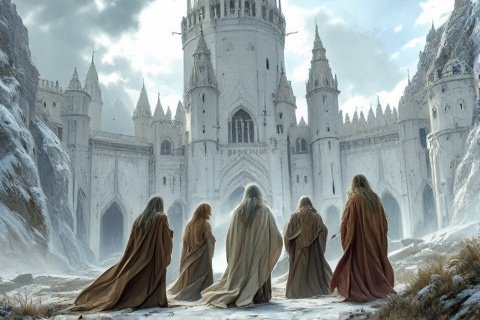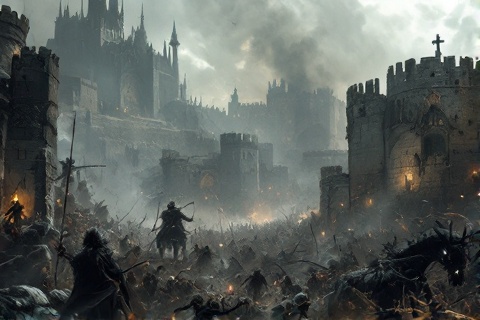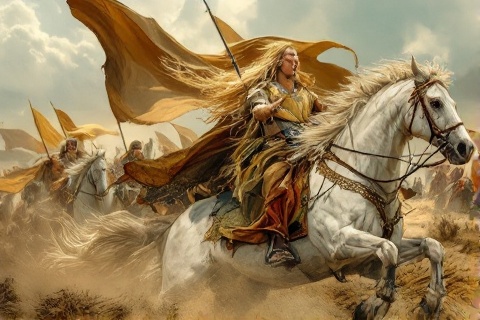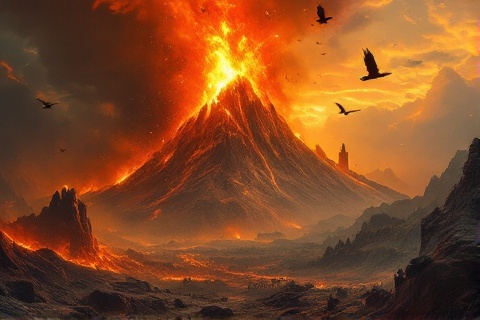
Legends of the Third Age
Unraveling the Chronicles of Middle-earth's Most Storied Era
The Dawn of the Third Age

The Third Age began in the year 3441 of the Second Age with
the momentous defeat of Sauron by the Last Alliance of
Elves and Men. Led by Gil-galad, the High King of the
Noldor, and Elendil, High King of the Dúnedain, this grand
coalition besieged Barad-dûr for seven years before finally confronting Sauron
himself. In the final battle on the slopes of Orodruin, both Gil-galad and
Elendil fell, but Isildur, using the broken shard of his father's sword
Narsil, cut the One Ring from Sauron's
hand, bringing about his defeat.
Following Sauron's defeat, Isildur made a decision that would shape the history
of Middle-earth for millennia to come. Against the counsel of Elrond and
Círdan, who urged him to cast the One Ring
into the fires of Mount Doom where it was forged, Isildur claimed the Ring as
weregild for his father's and brother's deaths. This choice would haunt his
lineage and all the Free Peoples of Middle-earth, as the Ring's survival meant
Sauron's spirit could never truly be vanquished.
In the aftermath of the Last Alliance's victory, the survivors of
Númenor's downfall established two great kingdoms in
Middle-earth. In the north, Arnor was founded by Elendil's line,
while in the south, Gondor flourished under the joint rule of
Isildur and Anárion's heirs. These realms of the Dúnedain became bastions of
Númenórean culture and learning in Middle-earth, preserving
the wisdom and traditions of their forebears while developing their own distinct
characteristics.
The Watchful Peace

Early in the Third Age, the Valar sent five powerful
Maiar to Middle-earth in the form of wizards, known as the
Istari. These beings, appearing as elderly men, included Saruman
the White, Gandalf the Grey, Radagast the Brown, and two
Blue Wizards who journeyed to the East. Together they formed the White Council,
though this formal body would not take shape until much later under the
leadership of Galadriel and eventually Saruman.
The establishment of the Shire in 1601 of the Third Age marked a
pivotal moment in hobbit history. The Hobbits, led by the
brothers Marcho and Blanco, received permission from the King of Arthedain to
settle the region between the Brandywine River and the Far Downs. The Hobbits
developed their own unique culture, characterized by love of peace, good food,
and the simple pleasures of life, while maintaining their ancient traditions of
farming and craftsmanship.
The early Third Age saw remarkable growth in the realms of Men, particularly in
Gondor and Arnor. Cities flourished, trade routes expanded, and great works of
architecture and engineering were undertaken. The white city of Minas Anor and
the coastal city of Pelargir became centers of learning and commerce, while the
northern capital of Annúminas stood as a testament to Númenórean craftsmanship.
Unknown to the Wise, Sauron's spirit had not been entirely vanquished with the
loss of the Ring. Around the year 1000 of the Third Age, he secretly established
himself in the fortress of Dol Guldur in southern Mirkwood.
Taking the form of a dark sorcerer known as the Necromancer, he began slowly
rebuilding his power and gathering evil creatures to his service while the Free
Peoples remained unaware of his true identity.
The Rise and Fall of Arnor

The year 861 marked a significant turning point in the history of the Northern
Kingdom when, following the death of King Eärendur, Arnor was divided among his
three sons. Amlaith, the eldest, received Arthedain, which included the capital
of Fornost and most of the western lands. His brothers established the realms of
Cardolan along the Great East Road and Rhudaur in the wild northeastern
territories, leading to centuries of rivalry and weakening the once-unified
kingdom.
From the frozen wastes of the North arose the realm of Angmar in 1300, led by
the Witch-king, who was secretly the chief of Sauron's Nazgûl.
The Witch-king established his capital at Carn Dûm and began a calculated
campaign against the divided northern kingdoms. Through military might and dark
sorcery, he particularly targeted Arthedain, recognizing it as the strongest of
the three realms and the keeper of the palantíri.
The final destruction of the northern kingdom came gradually but inexorably.
Rhudaur fell first to Angmar's influence, becoming a puppet state. Cardolan was
devastated by warfare and the Great Plague, its people scattered or slain.
Finally, in 1974, Arthedain itself fell to the forces of Angmar, with King
Arvedui fleeing north to perish in the Ice Bay of Forochel, marking the end of
the northern kingdom of the Dúnedain.
Gondor's Golden Age and Decline

Under the Ship-kings, beginning with Tarannon Falastur in 830, Gondor expanded
its influence dramatically along the coasts. These warrior-kings built great
fleets and extended Gondor's power south along the coasts to Umbar and north to
the port of Vinyalondë. Their conquests brought unprecedented wealth and
influence to Gondor, establishing it as the predominant maritime power in
Middle-earth.
In 1636, the Great Plague swept through Middle-earth with devastating effect.
Beginning in the East, it reached Gondor through its eastern territories and
spread rapidly. The White City was particularly hard hit, losing its King
Telemnar and his children. The Plague decimated populations throughout Gondor
and reached as far as Eriador, leaving many regions depopulated and contributing
to the decline of several realms.
The Kin-strife, beginning in 1432, marked one of the darkest chapters in
Gondor's history. The conflict erupted over King Valacar's marriage to a
non-Númenórean woman and the right of their son Eldacar to inherit the throne.
Led by Castamir the Usurper, rebels seized power, leading to a devastating civil
war that lasted ten years and significantly weakened Gondor's military and
political strength.
The capture of Minas Ithil by the Nazgûl in 2002
represented a severe blow to Gondor's defenses and morale. The city, renamed
Minas Morgul, became a place of terror and evil under the
leadership of the Witch-king of Angmar. The loss of this strategic fortress
exposed Gondor's eastern flank to Mordor and led to the abandonment of Ithilien
by most of its inhabitants.
The Long Winter and Rohirrim

The founding of Rohan occurred in 2510 when Eorl the Young led his people, the
Éothéod, south to answer Gondor's call for aid. After the decisive victory at
the Field of Celebrant, Steward Cirion granted Eorl and his people the province
of Calenardhon in perpetuity. Eorl swore an oath of eternal friendship between
Rohan and Gondor, known as the Oath of Eorl, which would prove crucial in the
wars to come.
The Rohirrim developed a distinct culture centered around their horses and the
vast grasslands of their new home. Their society valued courage, loyalty, and
martial prowess, with their cavalry becoming legendary throughout Middle-earth.
The Rohirrim built their capital of Edoras, with the golden
hall of Meduseld as its crown, and developed their own language and customs
while maintaining their ancient traditions.
The early years of Rohan were marked by constant warfare against both the
Dunlendings, who claimed the land as their ancestral home, and the Easterlings,
who sought to expand westward. These conflicts helped forge the Rohirrim into a
formidable military force, with their mounted warriors proving essential in
defending both their own lands and coming to Gondor's aid in times of need.
The Shadow Grows
Around 2460, Sauron returned to his fortress of Dol Guldur with increased
strength, causing the once-beautiful Greenwood to become dark and dangerous,
earning it the new name of Mirkwood. His presence caused evil creatures to
multiply, and a shadow fell over the forest. The wood-elves under
King Thranduil were forced to retreat northward,
establishing their halls in the healthier portions of the forest.
The awakening of Durin's Bane, a Balrog of Morgoth, in the mines of Moria in
1980 led to a catastrophic exodus of the dwarven population. King Durin VI and
his son Náin I were slain by the creature, and the surviving dwarves fled their
ancient home. This disaster scattered the dwarves of
Khazad-dûm across Middle-earth, with many settling in the
Grey Mountains and eventually the Lonely Mountain.
In the northern regions of Middle-earth, dragons became an increasing threat to
both dwarves and men. The great cold-drakes drove the dwarves from their realms
in the Grey Mountains, while fire-drakes like Smaug brought
devastation to human settlements. The greatest of these attacks was Smaug's
descent upon Erebor in 2770, which destroyed both the dwarven
kingdom and the nearby city of Dale.
The White Council, led by Saruman but including powerful members such as
Galadriel, Elrond, and Gandalf, took action against the growing darkness in
Middle-earth. Their most significant achievement was the attack on Dol Guldur in
2941, which drove Sauron from the fortress temporarily. However, this victory
proved hollow, as Sauron had already prepared his return to Mordor.
The War of the Ring

The discovery of the One Ring by Bilbo Baggins,
though its true nature remained unknown for decades, set in motion the events
that would define the end of the Third Age. When Gandalf confirmed the Ring's
identity in 3018, Frodo Baggins undertook the perilous quest to destroy it,
leaving the Shire with his companions and eventually joining the Fellowship of
the Ring at Rivendell.
The breaking of the Fellowship near Parth Galen marked the beginning of multiple
simultaneous conflicts across Middle-earth. While Frodo and Sam journeyed toward
Mordor, Rohan faced extinction at Helm's Deep, Gondor endured the Siege of Minas
Tirith, and battles raged from the lonely Mountain to the borders of
Lórien. The Free Peoples fought desperately against
Sauron's forces on numerous fronts.
On March 25, 3019, the Ring was finally destroyed when Gollum, wrestling with
Frodo at the Cracks of Doom, fell into the fires of Mount Doom with the Ring.
This act brought about Sauron's permanent defeat and the destruction of his
physical form, ending his threat to Middle-earth forever. The towers of
Barad-dûr crumbled, and Sauron's armies lost their will to fight.
Following the victory, Aragorn was crowned King
Elessar of the Reunited Kingdom, bringing together the realms of Gondor and
Arnor once more. His coronation marked the fulfillment of ancient prophecies and
the restoration of the line of Elendil. His marriage to Arwen, daughter of
Elrond, symbolized the union of the greatest houses of Elves and Men.
The End of the Third Age

The departure of the Ring-bearers marked the beginning of the end of the Third
Age. On September 29, 3021, Frodo Baggins, Bilbo Baggins, and the three Keepers
of the Elven Rings - Galadriel, Elrond, and Gandalf - sailed from the Grey
Havens into the West. This Last Riding of the Keepers of the Rings symbolized
the passing of the Elder Days and the magic they represented.
With the departure of the Ring-bearers and the defeat of Sauron, the Dominion
of Men truly began in Middle-earth. The time of the Elves and
other magical beings waned, and the responsibility for shaping the world's
destiny fell to mortals. King Elessar's reign ushered in a new age of prosperity
and peace, though one increasingly devoid of the ancient powers and wonders.
The fading of the Elves from Middle-earth accelerated in the years following
Sauron's defeat. The great Elven realms of Lothlórien and Rivendell gradually
emptied as their inhabitants answered the call of the Sea. Many departed from
the Grey Havens, sailing to the Undying Lands in the
West, leaving Middle-earth to the race of Men and marking the definitive end of
the Third Age.
